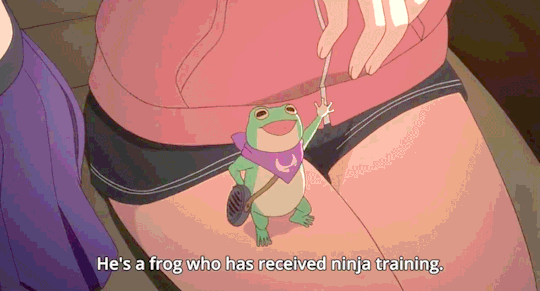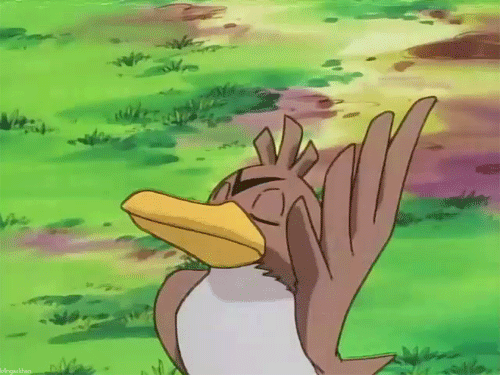Teatro Mágico. Entrada no para cualquiera. No para cualquiera. ¡Sólo para locos!
Don't wanna be here? Send us removal request.
Text






Moments in time, preserved through sentiments Twitter | Ko-Fi | Patreon
235K notes
·
View notes
Text
Moderately Interesting Japanese Episode 9: Animal Proverbs in Japanese

I have no idea what show this is from, but it’s so cute lol
I have a thing for Japanese. As you’ve likely noticed. And there are many aspects of the language that interest me, but one area in particular is 諺 kotowaza, or proverbs.
There are many intriguing proverbs, but today I’m going to focus on those that revolve around animals. How many did you already know?

蛙の子は蛙 A frog’s child is a frog
Japanese pronunciation: Kaeru no ko wa kaeru English equivalent: Like father like son.*
I put an asterisk next to the English equivalent because it is not 100% equal. The English expression “like father like son” is often used in a positive light, expressing pride in the child for taking after the parent’s good qualities. It can also be used in a negative way, but I feel that the positive nuance is stronger.
However, the Japanese expression is only negative. When a frog is born it is not a frog but tadpole, which looks like an entirely different animal. Slowly but surely, though, the frogspawn changes until it is identical to its parents. This is a metaphor for children who seem able of surpassing their parents, but who ultimately wind up just like them.
For example, say that there are a mother and father who are not artistically inclined, and their young daughter draws a pretty good picture. They think that she will become a great drawer much better than they could ever be, but as time passes they realize that she is just as mediocre at drawing as they are. They may sigh and say, “Kaeru no ko wa kaeru.”

鹿を追う者は山を見ず He who chases the deer fails to see the forest
Japanese pronunciation: Shika wo ou mono wa yama wo mizu English Equivalent: You cannot see the wood for the trees.
Imagine a hunter who chases a swift deer through the mountain forest. He is so intent on his prey that he does not realize where he going, and by the time he has caught the deer, he is completely lost and darkness is falling. This expression is about people who are so fixated on one thing that they lose sight of other important things.
This expression is very similar to the English “You cannot see the wood for the trees,” which refers to someone who does not notice small but crucial details.

猫に小判 Gold before cats
Japanese pronunciation: Neko ni koban English equivalent: Pearls before swine
A “koban” is a large gold oval coin that was used for many centuries as currency in Japan. You could think of it as a hundred dollar bill in terms of worth compared to other Japanese coinage at the time.
Naturally, while a koban held a large amount of significance for any person, if you gave it to a cat the cat wouldn’t know what to do with it. It would probably give it a curious whiff and then walk away. This expression is used when someone’s gift or efforts are wasted on the recipient. It’s the exact same as the English “pearls before swine.”
Also, as a fun little side-note, anybody who’s in my generation or younger should know this, but can you name the first-generation cat Pokemon that was a Team Rocket henchman? Do you remember what he had on his forehead?

Who’s that Pokemon?! It’s Meowth! The golden coin on his forehead is shaped like a koban and is a reference to this proverb. There’s a fun fact you can share with your Pokemon-loving friends.

前門の虎、後門の狼 A tiger at the front gate, a wolf at the back gate
Japanese pronunciation: Zenmon no tora, koumon no ohkami English equivalent: Between the devil and the deep blue sea, or, between a rock and a hard place
Imagine that you have sneaked into the enemy’s fortress but were seen by the guards. You must escape through either the front or rear gates of the castle walls, but at the front gates waits a ferocious tiger and at the rear gates snarls a hungry wolf. Either will end poorly for you, yet you must choose one or the other. This expression refers to a situation in which neither of the available options are good.
When thinking of an equivalent English expression, the first one that came to mind was “between a rock and a hard place,” but it turns out that this expression is only about 100 years old. I wanted something with a bit more seniority, and that was when I stumbled across “between the devil and the deep blue sea,” which I had only known as a lyric in an Aerosmith song until then haha. It turns out this expression was first recorded in English almost 400 years ago though.

猫に鰹節の番をさせる Setting the cat to guard the dried fish
Japanese pronunciation: Neko ni katsuobushi no ban wo saseru English equivalent: Setting the fox to guard the henhouse
I really like this one. First, you need to know what “katsuobushi” is, which I loosely translated as “dried fish.” It’s actually tissue paper-thin shavings of dried bonito, and cats absolutely love the stuff. And why wouldn’t they? It’s got the strong taste and smell of fish that they crave without the hassle of having to pick out bones or tear through scales.
Therefore, you can imagine that a cat would not a trustworthy guard make. This expression is identical to the English “setting the fox to guard the henhouse.”

They smoke the bonito for a ridiculously long time until it looks like a fossilized banana, and then they shred it up with a fancy box. Voila, katsuobushi.

This is an official advertisement for katsuobushi from about 1843. The cats are spelling out かつを (katsuo).

鴨がネギをしょってくる A duck comes bringing leeks
Japanese pronunciation: Kamo ga negi wo shottekuru English equivalent: ??
This one is a bit of head-scratcher lol. First, you need to know that there is a Japanese dish called “kamo nabe,” which is a duck stew with leeks. If a duck comes to you on its own, that in and of itself is a good thing for you. If it is also carrying leeks, it is even better. In other words, this expression is used when two or more convenient/beneficial things happen at the same time.
However, there is another underlying message of this expression that makes it difficult to find a matching English expression. That is, that the duck who unknowingly seals his fate is naive/foolish. Also, a duck is seen as an easy-to-trick or simple-minded bird. (Think of the English expressions “sitting duck” and “lame duck.”)
Specifically, this expression is used when Person A unknowingly does something beneficial for Person B that will later come back to hurt Person A.
I hunted for an equivalent expression in English but couldn’t find one. If you know of one in English or another language, please let me know in the comments!
Also, there is another Pokemon based on this expression. Do you know which one it is?

Yep, it’s Farfetch’d! Its name in Japanese is カモネギ (Kamonegi), or Leek Duck. Two Pokemon facts in one post? How much better can it get?

取らぬ狸の皮算用 Counting the pelts of raccoon dogs one has yet to catch
Japanese pronunciation: Toranu tanuki no kawazanyou English equivalent: Counting your chickens before they’ve hatched
The Japanese version of this well-known expression is decidedly darker than the English one. Imagine a hunter laying a dozen traps for raccoon dogs (called “tanuki” in Japanese) and bragging to his friends how he was going to catch 12 in a day. Upon checking the traps, he sees that he has only caught five. His friends would say, “Don’t count your pelts before you’ve caught them.”

立つ鳥跡を濁さず A bird taking flight does not foul the water
Japanese pronunciation: Tatsu tori wa ato wo nigosazu English equivalent: Burn no bridges
This expression can be heard on an almost daily basis in Japan. When a bird takes off from the water, it leaves behind clear, clean water only. There is no trace that it was ever there once the ripples have faded.
This is most commonly used when someone quits their job. It is important to leave no unfinished business or messes for your coworkers to clean up after you, and of course you want to leave on a good note with everyone. When you depart, you should make sure that you leave no unfavorable traces of yourself behind.
I guess that the closest English expression would be “burn no bridges,” though I saw several people stating “It’s an ill bird that fouls its own nest” as an equivalent. I feel like that expression is different, though, because it focuses more on the the perpetrator and less on the people around him, while the Japanese expression is all about making sure not to inconvenience others.

井の中の蛙、大海を知らず A frog at the bottom of a well knows nothing of the great ocean
Japanese pronunciation: I no naka no kawazu, taikai wo shirazu English equivalent: He that stays in the valley shall never get over the hill.
We all know at least one person who is woefully narrow-minded, not for lack of effort but simply because their world extends only to their city limit. They do not travel, do not have friends from varied backgrounds, and do not actively seek out the unfamiliar. This leaves them unaware of all the world has to offer.
The Japanese expression summarizes this predicament beautifully. A frog living in the bottom of a well may think that he is in the great expanses of the sea, but in actuality is in a prison, starved from all the wonders of light and sensation that are waiting outside the well.

The End!!
I hope you guys enjoyed today’s Moderately Interesting Japanese. Work has been…absolute chaos. My old boss was moved to a new project within the company. They’re shorthanded and I’ve been asked to translate over 30,000 pages of high level tech training materials (that I have no experience/knowledge of) into Japanese…in 5 weeks…on top of my regular duties… Needless to say I am exceedingly close either to drinking enough caffeine that my third eye opens, my chakras align, and I become an omnipotent god, or a mental breakdown. But I only have 2,000 more pages to go until I’m finished!
My queue of word of the day posts is running low and it might be a few days until I can get some more ready, but please be patient. I still have tons of cool words I want to share with you! ♡
4K notes
·
View notes
Text
2019年7月10日 12時03分
08日/30日.
08. Record yourself talking in Japanese. Listen to it and make notes on your pronounciation.
DUDES, I FOUND THIS AWESOME JAPANESE POEM FOR PRONOUNCIATION PRACTICE!
It really works out your mouth, I totally recommend it if you want to improve your pronounciation! i’m going to try to do this daily. There’s a slow & fast version in the video below!https://m.youtube.com/watch?v=W_JcI0kkjgo
Amenbo no Uta - Hakushuu Kitahara
Romaji:
amenbo akaina a i u e o
ukimo ni koebi mo oyoideru
kaki no ki kuri no ki ka ki ku ke ko
kitsutsuki kotsu kotsu karekeyaki
sasage ni su wo kake sa shi su se so
sono uo asase de sashimashita
tachimasho rappade ta chi tsu te to
tote tote tatta to tobitatta
namekuji noro noro na ni nu ne no
nando ni numette nani nebaru
hato poppo horo horo ha hi hu he ho
hinata no oheya nya fue wo fuku
maimai nejimaki ma mi mu me mo
ume no mi ochitemo mi mo shimai
yakiguri yudeguri ya i yu e yo
yamada ni hi no tsuku yoi no ie
raichou wa samukaro ra ri ru re ro
renge ga saitara ruri no tori
wai wai wasshoi wa i u e wo
uekiya idogae omatsuri da
ひらがな:
あめんぼあかいなあいうえお
うきもにこえびもおよいでる
かきのきくりのきかきくけこ
きつつきこつこつかれけやき
ささげにすをかけさしすせそ
そのうおあさせでさしました
たちましょらっぱでたちつてと
とてとてたったととびたった
なめくじのろのろなにぬねの
なんどにぬめってなにねばる
はとぽっぽほろほろはひふへほ
ひなたのおへやにゃふえをふく
まいまいねじまきまみむめも
うめのみおちてもみもしまい
やきぐりゆでぐりやいゆえよ
やまだにひのつくよいのいえ
らいちょうはさむかろらりるれろ
れんげがさいたらるりのとり
わいわいわっしょいわいうえを
うえきやいどがえおまつりだ
i messed up so many times, but had so much fun!
-i.
889 notes
·
View notes
Photo
Alguien debería regalarme un pastel con forma de cerveza





Tortas hiperrealistas.
1K notes
·
View notes
Text

Nighthawks
1942
Edward Hopper
Vi esta pintura hace algunos meses (o a lo mejor el año pasado; quién sabe, no tengo buen sentido del tiempo) y me gustó, más no le di mayor importancia. Y lo que voy a explicar sobre esta pintura me ha pasado con otras pinturas también, pero no con tanta frecuencia como con ésta. La cosa es que es una pintura bastante sencilla y bonita, por lo que es fácil de recordar; tal vez por eso me ha pasado con más frecuencia con esta pintura.
Pero bueno, ese algo que me ha pasado con esa pintura es algo bastante sencillo y común, pero que me hace pensar en dos cosas bastante inquietantes.
La primera es una con la que seguramente más de uno se sentirá identificado (al menos eso espero): cuando escuchas por primera vez una canción que te llama la atención (o la escuchas después de mucho de no haberla escuchado), o una palabra, o cualquier cosa, y empiezas a verla en todas partes; reproducen la canción en la radio, alguien que conoces utiliza esa palabra, alguien menciona esa película...
La primera vez puedes pensar que es una simple y quizás hasta agradable coincidencia; la segunda ya deja una ligera sensación de molestia, y de la tercera en adelante, empiezas a sentir una inquietante sospecha.
La segunda es inquietante de una manera diferente, no sé si haya muchos en mis contactos que se identifiquen con ella, y es que es algo que creo que es difícil que pase con otra cosa que no sea pintura y literatura. Y es que después de haber visto esa pintura, te encuentras viendo una película, ¡Y ves que de repente en una escena recrean esta pintura!; a veces de manera sutil y otras veces muy evidente. Y entonces ¡Zaz! Te llega esta inquietante pregunta que es la principal razón por la que empecé a escribir todo este palabrerío: ¡¿De cuántas referencias como ésta me habré estado perdiendo a lo largo de mi vida?!
¡Y es que es una sensación tremenda cuando te pasa esto, porque es algo que sabes que no cualquiera podrá notar! Tú pudiste hacerlo porque a lo mejor dio la casualidad (como fue mi caso) de que viste esa pintura y te gustó, se quedó en tu mente, y gracias a eso ahora puedes darte cuenta cuando en una película, una serie, etc., hacen referencia a esa pintura.
Y bueno eso me pasó con esta pintura. Luego de haberla visto he empezado a encontrarla referenciada en distintas películas, series e incluso anime. De hecho justo empecé a escribir esto después de haberla encontrado en un anime que estoy viendo, ya que me pareció muy curioso encontrarla ahí, en algo producido en Japón.
Como sea, si llegaste hasta aquí, espero que empieces a notar esta pintura en distintos lados al igual que yo. 😈😇
0 notes
Text
5 great tips on how to learn a new writing system
Many of the languages that we learn have another writing system, to name some: Russian, Armenian, Hindi, Arabic, Greek, Mandarin, Japanese, Korean and so forth. But sometimes we even have to learn some new letters for a variation of the Latin script in another language that uses it. For learning a new writing system you can do various kind of stuff and sometimes you need to try different methods to find one that fits your needs. And I guess not every method will be suitable for every type of writing system out there, because there are differences in writing systems. We can encounter an alphabet, consisting of letters where each segment is written on its own and corresponds to a sound, like the Latin script or in Greek. On the other hand we can also find writing systems that use syllables. These syllables often consists of a vowel that is “bound” to the consonant or a vowel on it’s own (often found with another symbol for a “free” vowel). Languages that use this kind of writing systems are for example, Hindi and Korean. And then there are logographic writing systems where a whole character can be used for a word or a phrase. You can find this system in traditional Chinese characters and in the Kanji of Japanese.

Photo by picjumbo.com from Pexels
But let’s get to the fun part now! I’ll show you 5 great tips on how you can learn to write in a new writing system! Yay, isn’t that great?
1. Get used to the writing system
Before you start to learn what each symbol corresponds to, you should learn how the writing system “feels”. What I mean is that you should go and find an article on Wikipedia or a song that you like in your target language. Pick a part of the text, as much as you want to write, and get used to writing in your new writing system. This gives you a feeling for each segment and how they work together.
2. Learn the “symbols”
After getting used to the appearance and “feeling” of the writing system, you should start to learn the symbols, and their corresponding sounds of course as well. You can look for an app, make your own flashcards or write them on a piece of paper and put it on your wall. Whatever works the best for you.
3. Actually write them down
This only applies to those who chose an app as an learning medium and didn’t write anything down as they went along with it. You should not only learn the symbols, you should also know how to write them. Search for writing templates that provide you each symbol to practice it one by one or just plainly write them down in your notebook until you know how to write them. (And stay tuned for something new on our Etsy store, regarding this point!)
4. “Nonsense” words
Before you start to write actual words of the language, start by writing “nonsense” words. These words could be names you know, actually names are not nonsense but I guess you get what I mean, or just words you come up with like: mimi, lalulop, tuztarit, etc. Just try to get used to your own writing “production” and write until you feel comfortable with combining the segments you learnt and with the rules behind it.
5. From beginning on
My last tip is about writing the actual words of your target language. Use it right away, from the beginning on, when you write something in your new target language! The best case for a serious language learner is to tackle the writing system first (also applies for pronunciation)! You will create a good base for any further learning. So my advice for you, again, is to start writing all the new words and phrases in your learnt writing system right away from the start! You will get used to it, even if you need some phonetic transcription at the beginning while you get used to writing and reading it.
I hope I was able to help you with these 5 great tips! And I guess not everyone is into writing system as I am but at least you should try to master its basics so it can be useful on your language journey! Have fun with this approach on how to learn a new writing system and feel free to try new things. Just try them out and tell us about your experiences on Instagram or Twitter. Chrissa

5 buenos consejos para aprender otros sistemas de escritura
Muchos de los idiomas que aprendemos tienen diferentes sistemas de escritura: ruso, armenio, hindi, árabe, griego, mandarín, japonés, coreano y muchos más. Pero a veces incluso tenemos que aprender variaciones del alfabeto Latino que incluyen algunos idiomas. Para aprender un nuevo sistema de escritura puedes hacer varias cosas y a veces tienes que probar diferentes métodos para encontrar uno que se adapte a tus necesidades y a cada idioma. Podemos encontrar un alfabeto que consista de letras individuales en las que cada segmento sea independiente y corresponde a un sonido específico, como el alfabeto latino y el griego. Por otro lado podemos encontrar sistemas que consistan en sílabas, estas tienen lo que conoceríamos como una consonante y una vocal o en ocasiones una vocal sola. Podemos encontrar ejemplos de este sistema en el coreano e hindi. Luego tenemos los logográficos, que identifican una palabra o incluso una frase, podemos encontrar este sistema en el kanji japonés y en el chino tradicional.

Photo by picjumbo.com from Pexels
Ahora vamos a la parte divertida. Te voy a enseñar 5 buenos tips para aprender un nuevo sistema de escritura. ¿Estás listo?
1. Acostumbrate a usarlo
Antes de que empieces a aprender a qué corresponde cada símbolo deberías aprender cómo se ve en contexto el sistema. Lo que quiero decir es que busques un artículo en Wikipedia o la letra de una canción. Elige una parte del texto, y copia la escritura a mano, ve acostumbrandote a utilizarlo. Esto te dará una idea de cada segmento y de cómo funcionan juntos.
2. Aprende los símbolos
Después de acostumbrarte a la apariencia y el sentido del sistema, deberías aprender a usar los símbolos y sus sonidos correspondientes. Para esto puedes buscar una app, crear tus propias flashcards o escribirlas en un papel y ponerlo en tu pared. Lo que mejor te funcione.
3. Escribelo
Esto aplica especialmente a los que les gusta aprender con apps y no lo escriben nunca. No solo deberías aprender a reconocer los símbolos sino también a producirlos. Puedes buscar plantillas que te ayuden a escribirlo uno a uno o puedes escribirlos en tu cuaderno hasta que te los aprendas. (Pronto habrá algo especial relacionado a este tema en nuestra tienda de Etsy)
4. Palabras sin sentido
Antes de escribir palabras reales en el idioma que aprendes puedes aprender a escribir palabras sin sentido. simplemente unir sonidos como: mimi, lalulop, tuztarit, etc. O puedes intentar con nombres que sepas y escribir este tipo de cosas hasta que te tengas mas confianza uniendo segmentos aplicando las reglas.
5. Desde el principio
Mi último consejo es que aprendas el idioma usando su sistema desde el primer día. Lo mejor que puedes hacer es enfocarte en el sistema de escritura primero (también aplica para la pronunciación). De esta manera vas a crear una buena base en el idioma que estés aprendiendo. Mi consejo para ti es que escribas las palabras nuevas que aprendas en el sistema correcto. Te acostumbras fácilmente incluso si lo acompañas de una descripción fonética.
¡Espero haberte ayudado con estos 5 consejos! y quizás no a todo el mundo le emocionen tanto los sistemas de escritura como a mi pero si te recomiendo que los aprendas correctamente porque serán sumamente útiles en tu proceso de aprendizaje. Diviértete con estas maneras de aprender y buscas tus propias maneras. Si las pruebas cuentanos como te fue a través de Instagram o Twitter. Chrissa

5 großartige Tipps für das Erlernen eines neuen Schreibsystems
Viele der Sprachen, die wir lernen, haben ein anderes Schreibsystem, um einige zu nennen: Russisch, Armenisch, Hindi, Arabisch, Griechisch, Mandarin, Japanisch, Koreanisch und so weiter. Aber manchmal müssen wir sogar einige neue Buchstaben einer Variante der lateinischen Schrift lernen, die von anderen Sprache verwendet wird. Um eine neues Schreibsystem zu lernen, kannst du verschiedene Sachen machen und manchmal musst du verschiedene Methoden ausprobieren, um die zu finden, die deinen Anforderungen entspricht. Und ich denke nicht jeder Methode wird passend für jedes Schreibsystem da draußen sein, denn es gibt Unterschiede in den Schreibsystemen. Wir können einem Alphabet begegnen, es besteht aus Buchstaben, bei dem jedes Segment einzeln geschrieben wird und einem Ton entspricht, so wie die lateinische Schrift oder in Griechisch. Auf der anderen Seite, können wir auch Schreibsystem finden, die Silben nutzen. Diese Silben bestehen meist aus einem Vokal, die an einen Konsonanten “gebunden” ist oder aus einem alleinstehenden Vokal (oft mit einem anderen Symbol für den “freien” Vokal). Sprachen, die dieses Schreibsystem nutzen, sind z.B. Hindi and Korean. Und dann gibt es logografische Schreibsysteme, bei denen ein ganzer Zeichen für ein Wort oder eine Phrase genutzt werden kann. Du kannst dieses System in traditionellen, chinesischen Zeichen und im Kanji des Japanischen finden.

Photo by picjumbo.com from Pexels
Aber lass uns nun zum spaßigen Teil kommen! Ich werde dir 5 großartige Tipps zeigen, damit du lernen kannst in einem neuen Schreibsystem schreiben zu können! Yay, ist das nicht toll?
1. Gewöhne dich an das Schreibsystem
Bevor du beginnst, zu lernen für was jedes Symbol steht, solltest du lernen wie sich das Schreibsystem “anfühlt”. Was ich damit meine, ist, dass du einen Artikel auf Wikipedia finden sollst oder einen Song, der dir in deiner Zielsprache gefällt. Such dir einen Teil des Textes aus, so viel wie du schreiben möchtest, und gewöhne dich daran, in deinem neuen Schreibsystem zu schreiben. Das gibt dir ein Gefühl für jedes Segment und wie sie zusammenarbeiten.
2. Lerne die “Symbole”
Nachdem du dich an die Erscheinung und das “Gefühl” des Schreibsystemes gewöhnt hast, solltest du die Symbole lernen, und ihre zugehörigen Töne natürlich auch. Du kannst nach einer App schauen, deine eigenen Karteikarten erstellen oder sie auf ein Blatt Papier schreiben und an die Wand hängen. Was immer am besten für dich funktioniert.
3. Schreibe sie wirklich aus
Das zählt nur für die, die eine App als Lernmedium benutzt haben und sich nichts notiert haben als sie damit gelernt haben. Du solltest nicht nur die Symbole lernen, du solltest auch wissen, wie man sie schreibt. Suche dir Schreibvorlagen, die dir jedes einzelne Symbol vorgeben, um es zu üben, oder schreibe sie einfach aus in deinem Notizbuch, bis du weißt wie sie geschrieben werden. (Und bleib gespannt auf etwas Neues in unseren Etsy Shop bezüglich dieses Themas!)
4. “Unsinnige” Wörter
Bevor du damit beginnst echte Wörter der Sprache zu schreiben, beginne damit “unsinnige” Wörter zu schreiben. Diese Wörter könnten Namen sein, die du kennst, eigentlich sind Namen kein Unsinn, aber ich denken, du weißt, was ich meine. Oder denke dir einfach Wörter aus, wie: mimi, lalulop, tuztarit, etc. Versuche dich einfach an deine eigene “Schreibproduktion” zu gewöhnen und schreibe so lange, bis du dich daran gewöhnt hast die Segmente zu kombinieren, die du gelernt hast, mit den Regeln, die dahinter stecken.
5. Von Anfang an
Mein letzter Tip handelt über das Schreiben der eigentlichen Wörter deiner Zielsprache. Benutzte es sofort, von Anfang an, wenn du etwas in deiner neuen Zielsprache schreibst! Das Beste für ernsthafte Sprachenlerner, ist es, das Schreibsystem zuerst zu bewältigen (das zählt auch für die Betonung)! Du wirst eine gute Basis für jedes weitere Lernen kreieren. Also, meine Rat an dich, nochmals, ist, dass du beginnen solltest deine Wörter und Sätze von Anfang an in deinem neu erlernten Schreibsystem zu schreiben! Du wirst dich daran gewöhnen, selbst wenn du am Anfang noch die phonetische Transkription brauchst, während du dich daran gewöhnst es zu lesen und zu schreiben.
Ich hoffe ich konnte dir mit diesen 5 großartigen Tipps helfen! Und ich denke, nicht jeder steht so auf Schreibsysteme wie ich, aber du solltest wenigstens versuchen, die Grundlagen zu bewältigen, damit es dir nützlich auf deiner Reise in der Sprache ist! Habe Spaß mit dieser Herangehensweise über das Erlernen eines neuen Schreibsystemes und probiere gerne neue Dinge aus. Teste sie einfach und erzähl uns über deine Erfahrungen auf Instagram oder Twitter. Chrissa

323 notes
·
View notes
Video
I love this song
the acapella version of the “Let Us Adore You” reprise/mix with “Found” is really good for my soul and i just love it a lot
19K notes
·
View notes
Photo
Las amé todas








Steven Universe: The Movie + Songs
21K notes
·
View notes
Photo

Así se ve un Analema, el cual son múltiples fotografías de el sol desde el mismo lugar, a la misma hora, durante un año, integradas en una sola imagen.
El analema forma una curva que suele ser, aproximadamente, una forma de ocho (8) o lemniscata. Pueden observarse analemas en otros planetas del Sistema Solar, pero poseen una forma diferente al observado en la Tierra, pudiendo llegar a ser curvas diferentes de un ocho (en Marte es muy similar a una gota de agua) #Universo #Cosmología #DatoCurioso
111 notes
·
View notes
Photo










- I don’t know the original source/artist/poet. Found it on net and sharing.
759K notes
·
View notes
Photo

Salvador Dali ~ “The Burning Giraffe”, 1937
Dalí painted Burning Giraffe before his exile in the United States which was from 1940 to 1948. Although Dalí declared himself apolitical— “I am Dalí, and only that"—this painting shows his personal struggle with the battle in his home country. Characteristic are the opened drawers in the blue female figure, which Dalí on a later date described as “Femme-coccyx” (tail bone woman). This phenomenon can be traced back to Sigmund Freud’s psychoanalytical method, much admired by Dalí. He regarded him as an enormous step forward for civilization, as shown in the following quote. “The only difference between immortal Greece and our era is Sigmund Freud who discovered that the human body, which in Greek times was merely neoplatonical, is now filled with secret drawers only to be opened through psychoanalysis. <source>
1K notes
·
View notes
Photo

Just a little lower Marco.
But seriously, this scene i majorly symbolic of the implied relationship of these two. It is their breakup, Marco passed and now they have to part, and because of who and what Hekapoo is and what the flame was, there is no way to rekindle it. It’s time for his clock to turn back and hers to move forward. This is somber and sad if you think about it as the end of what seems like a very touching relationship, the parting of lovers or friends. Old friends.
I cannot wait until she returns.
637 notes
·
View notes
Text
“¿Acaso te sientes tan poco que te da miedo cuando alguien te da todo?”
— Teoría de la Fragilidad, Quetzal Noah (via quetzalnoah)
47K notes
·
View notes
Photo

Dato curioso para el frio que ya esta llegando :P #Humor #Física
594 notes
·
View notes
Video
101K notes
·
View notes




